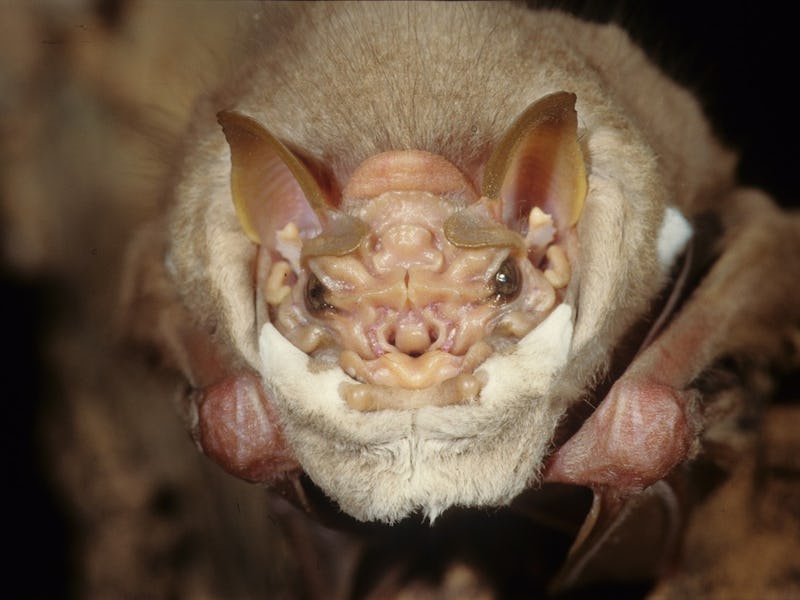This wrinkle-faced bat uses a bizarre face mask for sex
A bat observed in Costa Rica has a few tricks up its sleeve to attract potential mates.

Despite their huge presence in our cultural landscape and the news, we know strangely little about bats —especially their mating habits.
But a new study published Wednesday in PLOS ONE has unearthed a treasure trove of behavioral information for the first time about the male Centurio Senex bat, which lives in Mexico, Central America, and the northern parts of South America.
Specifically: a strange face mask that it uses to entice the ladies to reproduce.
According to the study's lead author, Bernal Rodríguez-Herrera, these male wrinkly-faced bats display a strange face mask prior to copulation, in addition to singing and beating their wings.
"We can conclude that males, as part of their display, keep the mask up. Not only do they do this, they also move their wings and emit different groups of ultrasonic sounds," Rodríguez-Herrera tells Inverse. Rodríguez-Herrera is an investigator at the Universidad de Costa Rica.
The Centurio Senex's wrinkly face is highly unusual compared to other New World Leaf Bats (Phyllostomidae). For one, it is missing the trademark leaf nose of bats in this family. It's also one of the few fruit-eating bats to also consume hard seeds.
Face off — But it's the white face mask that really makes the males of this species stand out.
The males have wrinklier faces compared with females, as well as a face mask that feels strangely appropriate in the time of Covid-19. The face mask takes the form of a flap of skin under the chin, which the male can raise or lower with ease.
A male wrinkle-faced bat with face mask on full display.
Rodríguez-Herrera and his team studied adult Centurio Senex males over a nearly six-week period in Costa Rica. During that time, the researchers observed the bats partaking in a highly rare form of mating known as 'lekking,' which has been confirmed in only a handful of the 1400-plus bat species around the world.
Leks basically consist of territorial male bats that gather in a common mating ground, where they display certain sexual traits and behaviors to attract the attention of a potential mate.
The competitive elements of lek courtship could rival The Bachelorette. The males engage in intense competition, and the ones with better displays have a much higher chance of finding a willing partner.
When engaging in lekking behavior, males find a perch in the common mating area, usually arriving around dusk and departing before midnight. They can go long periods without eating, focusing solely on the task of luring a female bat to their hanging perch.
The different stages of wrinkle-faced bat courtship show the male 'removing' his face mask.
During the study, researchers observed a female visitor approaching a perched male with a raised face mask, who subsequently whistled.
In the minute before copulation, the hanging male produced short vocalizations, or "songs," consisting of an echolocation sequence to locate the female, a trill, a wing beat, and a whistle.
The visitor left, then returned shortly after, landing very close to the male. As they mated, the male bit the fur of the female, which, apparently bored, departed after 30 seconds, despite the male trilling to convince her to stay. Better luck next time.
Bat courtship in action.
More to learn — It appears that the face masks mostly function as a display for sex (also known as a sexual dimorphism), though scientists still aren't 100 percent clear on whether it carries another purpose.
"We do not know. Females do not have a mask; apparently other activities can be done without the mask," Rodríguez-Herrera says. "Although studies are lacking, everything indicates that the mask is strictly related to courtship."
Rodríguez-Herrera hopes this study will shed light on the unique copulating patterns of bats, as we currently understand less than 10 percent of bat species' (many) mating habits. And the lek is the rarest among them.
"This study helps to understand that these strong sexual dimorphisms may be related to the lek-like system. Possibly other species of the same group of Centurio have the same system," Rodríguez-Herrera says.
Abstract: Centurio senex is an iconic bat characterized by a facial morphology deviating far from all other New World Leaf Nosed Bats (Phyllostomidae).The species has a bizarrely wrinkled face and lacks the characteristic nose leaf. Throughout its distribution from Mexico to North-ern South America the species is most of the time rarely captured and only scarce informa-tion on its behavior and natural history is available. Centurio senex is frugivorous and one of the few bats documented to consume also hard seeds. Interestingly, the species shows a distinct sexual dimorphism: Adult males have more pronounced facial wrinkles than females and a fold of skin under the chin that can be raised in style of a face mask. We report the first observations on echolocation and mating behavior of Centurio senex, including synchro-nized audio and video recordings from an aggregation of males in Costa Rica. Over a period of 6 weeks we located a total of 53 perches, where during the first half of the night males were hanging withraised facial masks at a mean height of 2.35m. Most of the time, the males moved just their wing tips, and spontaneously vocalizedin the ultrasound range. Approaches of other individuals resulted in the perching male beating its wings and emitting a very loud, low frequency whistling call.Following such an encounter we recorded a copulation event.The observed aggregation of adult C.senex males is consistent with lek courtship,a behavior described from only few other bat species.